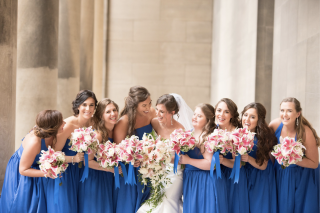The Celebrants Network Inc - BLOG
More Blog posts can be found in the Blog Categories to the right.
Understanding old wedding traditions.
Ever wondered why a bride used to wear a veil or carries flowers to the marriage ceremony? Celebrant Susie Roberts takes us through some well-known wedding traditions, and the history behind them...
Have you ever wondered about the symbolism and meaning of some of our old wedding traditions? Here are just a few of the old traditions explained. These are only some of the explanations for each of these practices. There are many more interpretations for these traditions depending on the country and the cultural norms of each community.
Veil
Why did brides wear veils? Veils originally symbolised virginity and purity and reportedly can be dated back to Roman times where the bride wore a complete head to toe cover.
In traditional weddings, a bride would wear the smaller face veil through the ceremony, with either her father lifting the veil, presenting the bride to her groom or the groom lifting the veil to symbolically consummate the marriage. The lifting of the veil would also reveal the beauty of the bride to her groom and all of the guests.
Veils these days are worn more as a fashion accessory to complement the bridal gown, and it is very rare to see the smaller face veil.

Father of the Bride “Giving Away The Bride”
This is an ancient tradition that dates back to when a female child was considered property, and the groom had to pay for the right to marry his beloved. The practice also implied that the bride was being handed from her family to origin to her husband’s family. This tradition has evolved of the centuries, and modern day brides who follow this custom, often see it as a nod of approval from their dad for their groom.
Many young brides have eliminated this tradition from their wedding entirely, or have adapted it to include both parents, family members, or even all of the guests.
Wedding Bouquet
Bouquets were originally bunches of herbs, garlic, grains and grasses intended to ward off any evil spirits who were lurking as the bride made her way down the aisle. When this old custom morphed into flowers, the bouquet formed part of the garlands worn by both bride and groom. which represent happiness.
Over time, bouquets became beautiful arrangements of flowers, symbolizing fertility and everlasting love. All flowers have symbolic meanings, and a wise florist will tell you of these meanings so you could weave a story into your bouquet.
The bouquet is also 'tossed' - single women gather behind the bride, who tosses the bouquet over her shoulder. The woman who catches the bouquet is said to be the next to get married.
Bridal Showers
It is reported that the very practical women of Holland started this tradition when a father of the bride didn’t approve of the groom, so didn’t provide a dowry and the bride’s friends clanned together to "shower" her with gifts so she would have the necessary dowry and marry the man of her choice. This tradition still remains, with groups of women often providing necessary household gifts for the bride to be.

The Best Man
Centuries ago, men often had to capture their brides, and took along a friend to help, the best man for the job! The role evolved through the centuries, with the best man also tasked with ensuring her family didn’t recapture the captured bride during the ceremony. These tales come from German folklore and the excavation of ancient altars has revealed many weapons possibly used by these best men!
Nowadays, the best man is normally tasked with keeping the wedding rings safe, and to stand with the groom to witness his wedding.
Bride standing to the left side of the groom
This tradition is also said to date back to the capturing of brides, with the groom having his right hand free to use for defence. There is also the more recent tradition of men walking on the right side of the footpath so that the woman is protected from traffic and any splashes from puddles.
Modern couples stand on the side that they are more comfortable with.
Garter Toss
Historically, the garter represents the virginity or purity of the bride, and in ancient custom there were witnesses at the marriage bed to ensure consummation, and the garter was used as evidence.
Nowadays, we have the garter toss, where eligible single men stand and wait for the garter to be tossed, and it is said that catching the garter brings good luck to the man who catches it, with him to be the next one to marry.

Something old, something new, a silver sixpence in her shoe
Something old, something new, something borrowed, something blue is a good luck saying that dates back to Victorian times and many brides still follow this old tradition.
- Wearing something old connects them to their family.
- Something new is said to represent good fortune and success for the bride.
- Something borrowed will remind the bride that friends and family will be there for her when help is needed.
- Something blue is the symbol of faithfulness and loyalty and very often the blue item is the garter.
- A silver sixpence in her shoe is to wish the bride wealth.

The Wedding Cake
Originally, wheat, bread and then cake was thrown at the bride as one of the many fertility based traditions surrounding a wedding, and this is reputed to have been changed to our modern tradition of eating the cake by the early Roman bakers.
Cutting of the cake is steeped in symbols. By placing his hand over the bride’s hand, this is said to signify that the groom will support his bride. Cutting through the bottom layer of the cake symbolises the continuity of their relationship. When the cake has been cut, the groom is meant feed his bride first, and then the bride will follow, signifying their commitment to care for each other, and ensuring good luck and fortune.

By accepting you will be accessing a service provided by a third-party external to https://www.celebrants.org.au/


Comments 2
Thanks for sharing this.
Thanks for this Susie. As a big history buff I love to know about all these old traditions. What a different time we live in, but strangely there is a real hunger with young people to know these traditions and in some cases follow them. I might be ' borrowing' a few of them for my social media posts. Hope this is OK.